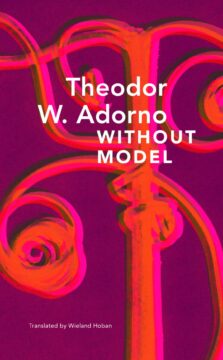Owen Hatherley at the London Review of Books:
 Adorno is easily parodied. Photos on social media show him frog-like, myopic and bald, denouncing the willing consumption of dross, the personal embodiment of a refusal to ‘let people enjoy things’. Another meme features Reverend Lovejoy from The Simpsons derisively brandishing a copy of Minima Moralia: ‘You ever sat down and read this thing?’ (In the original, it’s the Bible the reverend is holding up to ridicule.) Others use an image of Adorno in a one-piece swimsuit at the beach, looking as if he’s quietly enjoying himself – a more winsome George Costanza. These memes are surely made by people who had to study Adorno at university. They will probably have read the depressive aphorisms of Minima Moralia and some fragments from Dialectic of Enlightenment on the ‘culture industry’; a few unfortunates will have had to tackle the thickets of Aesthetic Theory or Negative Dialectics. Along with the parodies come received ideas: Adorno the grouch, Adorno the scourge of mass media, Adorno the mandarin Marxist; or, as Ben Watson puts it in his counterweight, Adorno for Revolutionaries (2011), Adorno as ‘a kind of German T.S. Eliot without the practical cats’.
Adorno is easily parodied. Photos on social media show him frog-like, myopic and bald, denouncing the willing consumption of dross, the personal embodiment of a refusal to ‘let people enjoy things’. Another meme features Reverend Lovejoy from The Simpsons derisively brandishing a copy of Minima Moralia: ‘You ever sat down and read this thing?’ (In the original, it’s the Bible the reverend is holding up to ridicule.) Others use an image of Adorno in a one-piece swimsuit at the beach, looking as if he’s quietly enjoying himself – a more winsome George Costanza. These memes are surely made by people who had to study Adorno at university. They will probably have read the depressive aphorisms of Minima Moralia and some fragments from Dialectic of Enlightenment on the ‘culture industry’; a few unfortunates will have had to tackle the thickets of Aesthetic Theory or Negative Dialectics. Along with the parodies come received ideas: Adorno the grouch, Adorno the scourge of mass media, Adorno the mandarin Marxist; or, as Ben Watson puts it in his counterweight, Adorno for Revolutionaries (2011), Adorno as ‘a kind of German T.S. Eliot without the practical cats’.
Adorno’s aesthetics are extreme. ‘He is an easy man to caricature,’ Watson writes, ‘because he believed in exaggeration as a means of telling the truth.’ But he was no misanthrope.
more here.
